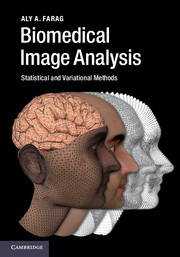Book contents
- Frontmatter
- Dedication
- Contents
- Preface
- Nomenclature
- 1 Overview of biomedical image analysis
- Part I Signals and systems, image formation, and image modality
- Part II Stochastic models
- Part III Computational geometry
- Part IV Variational approaches and level sets
- 10 Variational approaches and level sets
- Part V Image analysis tools
- Index
- References
10 - Variational approaches and level sets
from Part IV - Variational approaches and level sets
Published online by Cambridge University Press: 05 November 2014
- Frontmatter
- Dedication
- Contents
- Preface
- Nomenclature
- 1 Overview of biomedical image analysis
- Part I Signals and systems, image formation, and image modality
- Part II Stochastic models
- Part III Computational geometry
- Part IV Variational approaches and level sets
- 10 Variational approaches and level sets
- Part V Image analysis tools
- Index
- References
Summary
Objects captured in a scene may intersect and occlude each other in the field of view of an imaging sensor, and may suffer from uncertainties in the imaging process. The object shape may be described by its outline (contour). There exists a rich image analysis literature on approaches to extract the contours of objects. This chapter will focus on deformable models and level set methods to extract object contours. Active contours are curves that deform within an object representation (e.g., a digital image) in order to recover the object shape. They are classified as parametric or geometric, according to their representation and implementation. In particular, parametric active contours are represented explicitly in terms of parameterized curves in a Lagrangian formulation (e.g. [10.1],[10.2]). On the other hand, geometric active contours are represented implicitly as level sets of 2D distance functions, which evolve according to an Eulerian formulation. They are based on the theory of curve evolution implemented via level set techniques. Parametric active contours are the older of the two formulations.
Geometric active contours, also known as level set methods (LSM), handle topological changes during curve evolution (e.g. [10.3]). They describe an object contour by considering it as a slice through a higher-dimensional object known as the level set function. The contour intersects the level set function at the x–y plane, which is known as the zero-level set. Contour motion normal to the level set is given by a Hamilton–Jacobi partial differential equation (PDE). This chapter discusses the mathematical foundation of classical deformable models and level sets. LSM can be used for 2D or 3D object representations, and can address various topological and geometrical characteristics of the objects. These methods lead to solutions in the continuous domain [10.4][10.5]. Deformable models and LSM have been successful in image analysis, especially image segmentation and registration [10.6–10.11].
Information
- Type
- Chapter
- Information
- Biomedical Image AnalysisStatistical and Variational Methods, pp. 275 - 294Publisher: Cambridge University PressPrint publication year: 2014
